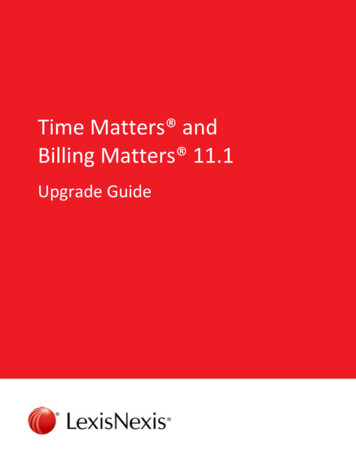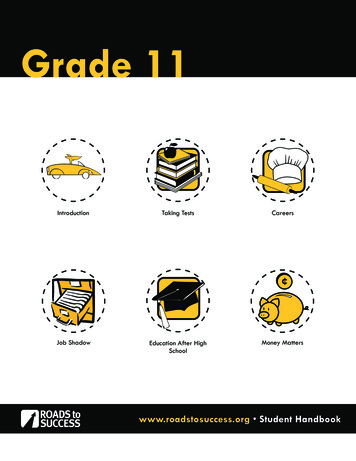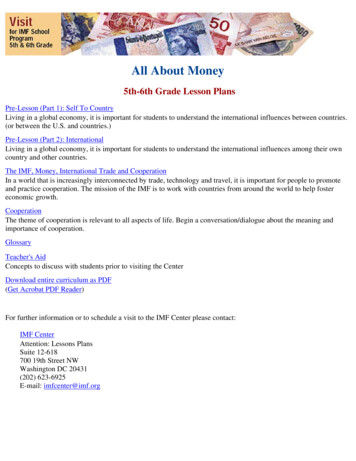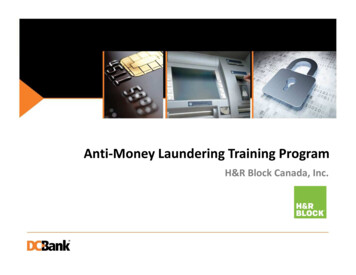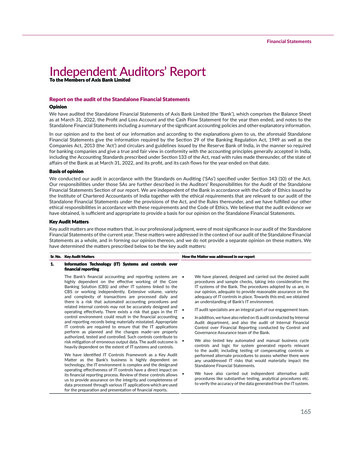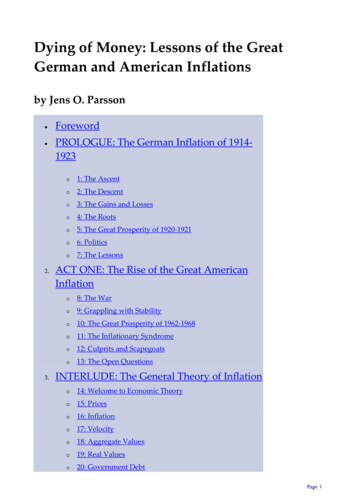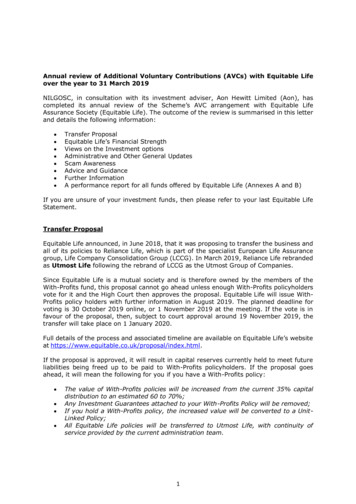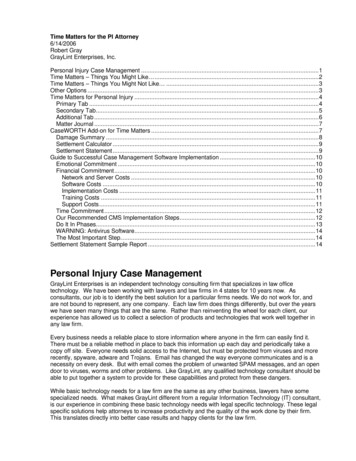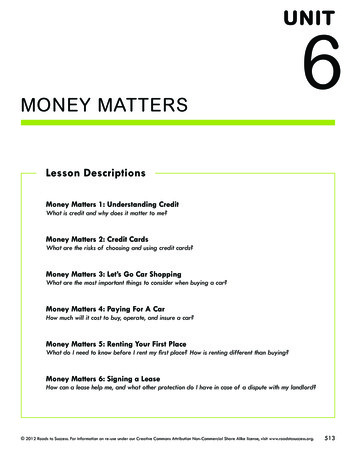
Transcription
UNITMONEY MATTERS6Lesson DescriptionsMoney Matters 1: Understanding CreditWhat is credit and why does it matter to me?Money Matters 2: Credit CardsWhat are the risks of choosing and using credit cards?Money Matters 3: Let’s Go Car ShoppingWhat are the most important things to consider when buying a car?Money Matters 4: Paying For A CarHow much will it cost to buy, operate, and insure a car?Money Matters 5: Renting Your First PlaceWhat do I need to know before I rent my first place? How is renting different than buying?Money Matters 6: Signing a LeaseHow can a lease help me, and what other protection do I have in case of a dispute with my landlord? 2012 Roads to Success. For information on re-use under our Creative Commons Attribution Non-Commercial Share Alike license, visit www.roadstosuccess.org.513
PLANNING PYRAMIDGRADE 11, Unit 6, Money MattersSome Students Will: Understand relationships betweendown payment, interest rate, and termof loan in determining a monthly carpayment.Most Students Will: Understand how high interest rates and minimum payments affect credit cardbalances. Know what to consider when choosing a credit card. Identify online resources for researching a car purchase. Understand how to determine a reasonable monthly car payment, given aparticular budget. Understand how to determine a reasonable monthly rent payment, given aparticular budget. Understand the contents of a lease, and know how to resolve problems re: arental property (for example, getting repairs made in a timely manner).All Students Will: Know what a credit rating is, where to find it, and its potential impact on aperson’s ability to buy a house or car. List advantages and disadvantages of credit cards. Identify criteria to consider when choosing a car. Understand the need for car insurance. Identify the costs of operating a car. Identify household expenses other than rent. Understand what to look for in a rental property.514 2012 Roads to Success. For information on re-use under our Creative Commons Attribution Non-Commercial Share Alike license, visit www.roadstosuccess.org.
Grade 11Money MattersFamily NewsletterFirst ApartmentRoads to Successis a new programdesigned to helpmiddle and high schoolstudents preparefor their futures. Thisnewsletter will keepyou posted on whatwe’re doing in school,and how families canfollow through at home.For more informationabout Roads to Success,please visit our website:www.roadstosuccess.org.Did you know?94% of students age16 to 22 say they’relikely to turn to theirparents for financialinfo.79% of students thisage have never takena personal financecourse in school.Source:www.consumerjungle.orgImagine you’re 18. You’reeager to start life on yourown. Will you buy a newcar? Live in luxury? There’sone question you’ll want toanswer before you make apurchase or sign a lease:How much can you afford?RentExperts say it’s safe tospend about 30% ofyour take-home pay on aplace to live. (So, if yourmonthly income is 1200,you should plan on paying about 360 for rent.)You’ll need another 5% forutilities. For many youngpeople, the cost of housingmeans sharing their firstapartment with roommates.Questions to AskApartment Questions: How much is the rent? Are utilities included? What security deposit isrequired? Is the neighborhood safe? How close is it to work,school, shopping, andentertainment?Personal BudgetUtilities5%Savings4%Recreation5%Other TransportationCredit: www.practicalmoneyskills.com Is it clean and in goodrepair? What extras are included? Is the landlord trustworthy?Roommate Questions: How will we split expenses? How will we sharechores? Do we agree on the basics:guests, noise, privacy,cleaning? What happens if someone loses his job or wantsto move out?LeasesLeases can cover everything from parking topaint color to pets. Leasesprotect both the landlordand tenant. Take the timeto read the lease carefully.If the landlord promisessomething that’s not in thelease, it’s wise to get it inwriting. Don’t assume thatrules in the lease won’t beenforced.For more bout.comGrade by GradeBy high school graduation, Roads to Success students should be able to create a budgetfor their first year of work or college. To prepare, 11th-graders focus on the top twohousehold expenses, housing and transportation. Topics include: Questions renters should ask Renting vs. buying a house Leases Buying a car Extra expenses: utilities, moving costs, household insurance;gas, maintenance, repairs, car insurance Credit card use 2012 Roads to Success. For information on re-use under our Creative Commons Attribution Non-Commercial Share Alike license, visit www.roadstosuccess.org.515
MONEY MATTERSUnderstanding Credit1The BIG Idea What is credit and why does it matter to me?AGENDAApprox. 45 minutesI. Warm Up: What Do You KnowAbout Credit? (10 minutes)II. Credit: The Good, The Bad,The Bottom Line (10 minutes)III. What Your Credit RatingMeans to You (15 minutes)IV. Finding Out Your Credit Rating(5 minutes)V. Wrap Up (5 minutes)MATERIALS STUDENT HANDBOOK PAGES: Student Handbook page 154,Your Car, Your Credit Student Handbook page 155, How MuchWill You Pay? Student Handbook page 156,What’s Behind Your Credit Rating? Student Handbook page 157,Credit Rating Quiz FACILITATOR PAGES: Facilitator Resource 1, Credit RatingScores Facilitator Resource 2, Credit Rating QuizAnswer Keyq Overhead projectorq Chart paper and markersq Calculators (one per student)OBJECTIVESDuring this lesson, the student(s) will: Understand credit, as well as its advantages and risks. Understand credit ratings and the advantages of having a good credit rating. Understand what actions lead to a good credit rating and a poor credit rating. 2012 Roads to Success. For information on re-use under our Creative Commons Attribution Non-Commercial Share Alike license, visit www.roadstosuccess.org.517
Grade 11,#, UnitMoneyNameMatters#: Lesson1: UnderstandingTitleCreditOVERVIEW.In this lesson, students read a scenario about making their first car purchase and reflect on whatthey know about credit and credit ratings. Next, they define credit and discuss its advantagesand disadvantages. Then they discuss credit ratings, and complete an activity in which theycompare car loans based on different credit ratings. Finally, they talk about what’s on a creditreport, how to access their own reports, and what to do if there are mistakes.PREPARATION.q The following handouts can be made into overhead transparencies or copied onto chartpaper: Student Handbook page 155, How Much Will You Pay? Student Handbook page 156, What’s Behind Your Credit Rating?q Print a copy of Facilitator Resource 1, Credit Rating Scores and cut out the individualscores to hand out to students in Activity III. You may wish to reproduce this on heavy paperso cards are reusable.q List the day’s BIG IDEA and activities on the board.q Write the day’s vocabulary words and definitions on the board.VOCABULARY.Credit: Money you borrow, for example, from a bank, with the promise to pay it back at a laterdate or over time.Interest: The fee paid for borrowing money; usually a percentage of the money borrowed.Credit report: A record of all the money you’ve borrowed, including credit cards, and your payment history.518 2012 Roads to Success. For information on re-use under our Creative Commons Attribution Non-Commercial Share Alike license, visit www.roadstosuccess.org.
Grade 11, MoneyGradeMatters#, Unit1: UnderstandingName #: LessonCreditTitleIMPLEMENTATION OPTIONS.If time is an issue, you may choose to omit the quiz in the Wrap Up, Student Handbook page157, Credit Rating Quiz.In Activity III, Student Handbook page 155, How Much Will You Pay?, if your students struggle with math, you may wish to calculate several examples as a class. 2012 Roads to Success. For information on re-use under our Creative Commons Attribution Non-Commercial Share Alike license, visit www.roadstosuccess.org.519
Grade 11, Money Matters 1: Understanding CreditACTIVITY STEPS.I. Warm Up: What Do You Know About Credit? (10 minutes)1. To begin this lesson, as students enter the classroom, refer them to Student Handbookpage 154, Your Car, Your Credit. Give students a few minutes to read the scenarioand answer the questions.2. SAY SOMETHING LIKE: Welcome, everybody. Before we look at your answers, I’dlike to see a show of hands. Who thinks they might apply for a credit card in the nextfew years? Who here is thinking about buying a car or a house in your future? And ifyou’re not going to buy a house, you’ll need to rent, right? And who thinks they justmight apply for a job at some point in their lives? Wow, that’s everyone! Well, if youthink you might do any of these things, then you need to understand and take care ofyour credit rating.3. SAY SOMETHING LIKE: Today we’re launching into a six-week unit that covers moneyand finances. This unit is called “Money Matters” because it’s all about money and howit matters to you as you think about life on your own. We’ll be spending this week andnext on credit and credit cards, followed by two lessons about buying and maintaininga car, and two lessons about renting an apartment. Today, we’re going to review whatwe mean by “credit,” the benefits and dangers of credit, what a credit rating is, andwhy it matters to your future.4. SAY SOMETHING LIKE: Now let’s take a look at the first question from Your Car, YourCredit. [Take a few minutes to let students share their answers. The second question isaddressed during Activity III.]II. Credit: The Good, The Bad, The Bottom Line (10 Minutes)1. SAY SOMETHING LIKE: Let’s start with the term credit. Can someone tell me, in yourown words, what credit is? [Let one or two students respond.] In short, credit is moneythat you borrow and pay back at a later date or over time. When you use a credit card,you’re borrowing money from the bank or financial institution that issued the creditcard. When you apply for a credit card, you’re making a promise that you’ll pay backthe money.Besides credit cards, what other times do we use credit? [Let students answer and writethem on the board. Make sure the list includes “Buying a house” (house loans or mortgages), “Buying a car” (car loans), and “Applying for financial aid for college” (school loans).]520 2012 Roads to Success. For information on re-use under our Creative Commons Attribution Non-Commercial Share Alike license, visit www.roadstosuccess.org.
Grade 11, Money Matters 1: Understanding Credit2. SAY SOMETHING LIKE: As you can see, credit is an important tool that you’ll probablyuse throughout your life. For example, people may not have the money up front to payfor college, but school loans allow them to go to college and pay back the loans whenthey begin their careers. And very few people have enough money in the bank topurchase a house without credit. Home mortgages allow them to own homes by payingback the loan over time.3. SAY SOMETHING LIKE: But credit has its downside, too. For starters, some peoplemay borrow more money than they can afford to pay back. This is especially true withcredit cards, because they’re easy to use and you can quickly lose track of how muchmoney you owe.4. SAY SOMETHING LIKE: But there’s another big disadvantage of using credit. [Youmay want to write this on the board.] Credit can cost a lot of money! In other words, theamount you pay back in the end is much more than the amount you borrowed to beginwith. Does anyone know why this is? [Take answers.]The answer is interest. Any loan comes with interest, an amount you pay in addition tothe money you borrow. Interest is usually a percentage of the money you borrow. Thehigher the interest, the more money you pay for a loan.Usually long-term loans, like those for homes, cars, and colleges, carry a lower interestrate. You might pay 18% annual interest (expressed as an Annual Percentage Rate) ona credit card loan, while a home loan might have an annual interest rate of closer to6%. On the other hand, long-term loans are just that – long term. So even though thathouse loan has a lower interest rate, you’re paying off the loan for over 30 years. Andthat means every year, your interest is adding up – and adding to the total amountyou owe.5. SAY SOMETHING LIKE: So, let’s look at the bottom line. Anytime you apply for a loanor decide to use credit, it’s important to determine how much you’re going to pay inthe end. This depends on three factors: The amount of money you borrow. The interest rate charged by the lending institution. The length of the loan – or how long it takes to pay back the loan. 2012 Roads to Success. For information on re-use under our Creative Commons Attribution Non-Commercial Share Alike license, visit www.roadstosuccess.org.521
Grade 11, Money Matters 1: Understanding CreditIII. What Your Credit Rating Means to You (15 minutes)1. SAY SOMETHING LIKE: We started this lesson with an activity about credit rating.Does anyone know what this is? [Take answers.]Your credit rating, also called a credit score, is an estimate of your ability to repaymoney you borrow. It’s based on your credit report, a record of all the money you’veborrowed – including credit cards – and your payment history. We’ll take a closer lookat what you’ll find in your credit report in a few minutes.Your credit rating depends on several different factors. Here are just a few: Your payment history: Do you pay off credit cards and other bills on time? A history of missed or late payments could hurt your credit rating. Your debt: How much money do you owe now? Having credit cards with high balances close to the limit could hurt your credit rating. Length of your credit history: How long have you had credit? The longer you’vehad credit (and used it wisely), the better your credit rating. The number of times you ask for credit: Have you applied for lots of cards in ashort period of time? If so, this could be a red flag to a creditor.All of these factors are considered to determine an individual’s credit rating. Peopleare assigned a number between 300 and 850 based on their past behavior usingcredit. The higher the number, the better the rating.2. SAY SOMETHING LIKE: Now you might be wondering what the big deal is. Who really cares about your credit rating and credit report? Well, a lot of people will. Afterall, your credit rating says a lot about your judgment and trustworthiness. Insurancecompanies, landlords, and even potential employers can check your credit report. Butmost of the people who review your credit report will be lenders, like loan and creditcard issuers. Anytime you apply for a loan or a credit card, the lender will automatically check your credit report.3. SAY SOMETHING LIKE: Now, let’s think back to that quiz we started the class with.Does anyone remember how your credit rating can affect a loan? [Take answers fromthe class.] In a nutshell, your credit rating determines if you get a loan and the interestyou pay on that loan. The higher your credit rating, the lower your interest rate. If you have a highcredit rating, it means a lender will feel safer lending you money because you’veproven your ability to repay loans in the past.522 2012 Roads to Success. For information on re-use under our Creative Commons Attribution Non-Commercial Share Alike license, visit www.roadstosuccess.org.
Grade 11, Money Matters 1: Understanding Credit The lower your credit rating, the higher your interest rate. If your credit ratingis low, a lender might doubt your ability to repay the loan. After all, if you didn’tmake payments or often paid late in the past, it’s likely you could do so again. Tosafeguard the loan, they’ll set a higher interest rate.If your credit rating is very low, you could get turned down for the loan. Ifyou’ve failed to make payments in the past, a lender won’t want to lend youmoney now.4. SAY SOMETHING LIKE: Now, remember that car loan from the first activity? I’m goingto assign each of you a credit rating and we’re going to find out what effect it has onyour car loan.Hand out the strips you cut from Facilitator Resource 1, Credit Rating Scores, so thatevery student is assigned a credit rating. Then have students turn to Student Handbookpage 155, How Much Will You Pay? Have students circle their assigned credit scoreon the chart.5. SAY SOMETHING LIKE: To purchase the car you found, you need a loan for 10,000.You’ve decided you need a 36-month loan, so it’s paid off in full in three years. Take aminute to look at the chart and answer the questions. When you’re done with questions1-4, please find someone near you with a credit rating that falls in a different category. Work together quietly to answer questions 5 and 6.6. Have students share information as a class to confirm that good credit provides significant savings over the life of a loan.IV. Finding Out Your Credit Rating (5 minutes)1. SAY SOMETHING LIKE: After that activity, you might be getting curious about thesecredit reports that determine your credit rating. As we discussed earlier, a credit report is basically a snapshot of your credit history. This history is collected and kept onfile by credit bureaus. A credit report includes the following information:Use chart paper or an overhead transparency of Student Handbook page 156,What’s Behind Your Credit Rating? to present this information, as students take noteson their own Student Handbook page. Personal Identification Information: Name, address, social security number, telephone number, and spouse’s name; past and present employer names and addresses. 2012 Roads to Success. For information on re-use under our Creative Commons Attribution Non-Commercial Share Alike license, visit www.roadstosuccess.org.523
Grade 11, Money Matters 1: Understanding Credit Public Record Information: Legal files, such as bankruptcies.Collection Agency Account Information: Details if a collection agency has contactedyou about an outstanding debt.Credit Account Information: Information on every account or loan in your name,such as: when it opened, the highest balance, present balance and payment history(including if any payments are past due and by how much).Inquiries: Companies that have requested your credit report, for a credit-card offer or application.2. SAY SOMETHING LIKE: You might think you’ll always know what’s on your creditreport, but it’s a good idea to check it about once a year. You want to make sure theinformation is up-to-date and accurate. You can do this by contacting one of the threecredit bureaus: Equifax (www.equifax.com) Experian (www.experian.com) Trans Union (www.transunion.com)These credit bureaus provide free reports once a year. You can access your credit report immediately if you request one online. If you call or write, it takes about 15 daysto receive one in the mail.3. SAY SOMETHING LIKE: If you find a mistake on your credit report, you can write thecredit bureau and it should be corrected within 60 days. But remember, you cannotremove correct information from your report, even if it has a negative impact on yourcredit rating. However, it won’t be there forever: account information remains on yourcredit report for seven years from the date it occurs.Of course, many of you won’t have a credit report yet. If you’ve never had a creditcard, or taken out a car loan, then there’s nothing to report. This is a great situation tobe in because you can start off with a blank slate.V. Wrap Up (5 minutes)1. As a final activity, have students turn to the Student Handbook page 157, Credit Rating Quiz. Give students a few minutes to answer the questions. When they’re done,review the answers together. See Facilitator Resource 2, Credit Rating Quiz AnswerKey.524 2012 Roads to Success. For information on re-use under our Creative Commons Attribution Non-Commercial Share Alike license, visit www.roadstosuccess.org.
Grade 11, Money Matters 1: Understanding Credit2. SAY SOMETHING LIKE: In this lesson, you’ve learned about credit and why it’s important to use it wisely. [Have a class discussion to review what you learned. Some questions to spark discussion include: What surprised you most about what you learned today? When we did the activity on car loans, who was assigned a credit rating under620? How did that feel to know you were paying so much money to the bank –and so much more than other students? What are two things you can do to make sure you have a good credit rating?]3. SAY SOMETHING LIKE: Next week, we’re going to talk about something that gets lotsof people into credit trouble — credit cards. As you’ve learned today, the way youuse your credit cards has a big impact on your credit rating, so it’s important to usethem wisely. We’ll learn more about using credit cards next week. 2012 Roads to Success. For information on re-use under our Creative Commons Attribution Non-Commercial Share Alike license, visit www.roadstosuccess.org.525
Grade 11, Money Matters 1: Understanding CreditFacilitator Resource 1, Credit Rating ScoresCredit Rating ScoresCut out the strips below and hand out one to each student when you assign 648625635642604594601612526513535547830717683657 2012 Roads to Success. For information on re-use under our Creative Commons Attribution Non-Commercial Share Alike license, visit www.roadstosuccess.org.
Grade 11, Money Matters 1: Understanding CreditFacilitator Resource 2, Credit Rating Quiz Answer KeyCredit Rating Quiz Answer KeyWhat have you learned about credit? Take this quick quiz to find out!1. Your credit rating is most influenced by:a) Your payment history on loans (including credit cards)b) The number of credit cards you ownc) Your past and present income2. If you have poor credit rating, you could:a) Be turned down for a car loanb) Have to a pay a higher interest rate, meaning higher paymentsc) Both3. If you’ve never had a credit card, then you probably have:a) A perfect credit ratingb) A poor credit ratingc) No credit rating4. Your credit rating is:a) Kept confidential, even from you, unless you apply for a loanb) Private information, and cannot be accessed unless you give written permissionc) Public information, and can be accessed by anyone from potential lenders to future employers (Future employers need written permission to access credit reports.)5. Information stays on your credit report:a) For one year from the date it occurredb) For seven years from the date it occurred (Bankruptcies remain on your report for 10 years.)c) Forever6. Which of these credit rating scores would give you the lowest interest rate?a) 820b) 620c) 5207. Your credit report includes your payment history for all your credit card accounts. It also shows:a) Past and present employersb) Where you’ve livedc) Both of these 2012 Roads to Success. For information on re-use under our Creative Commons Attribution Non-Commercial Share Alike license, visit www.roadstosuccess.org.
Grade 11, Money Matters 1: Understanding CreditStudent Handbook, Your Car, Your CreditYour Car, Your CreditIt is the year after graduation, and you’ve been saving your money to buy a car. You have asteady job, so you assume you’ll have plenty for monthly payments. If you don’t, you figure you’lljust cover extra expenses with your credit card. On the day you go to check out cars, it doesn’ttake long to find the one you want. Your heart is pounding with excitement. You’re thinking, this isthe day I drive off with my own car! You picture yourself gripping the leather steering wheel, thesun roof open, the windows down, your favorite song blaring from the radio .But as you walk into the dealership to start paperwork, the salesman says, “I think I can getyou a great deal on this baby, today. And we offer great financing, too – it all depends on yourcredit rating.” Suddenly, the image of you and your car is getting blurry and a queasy feeling isrising in your stomach as the words “credit rating” echo in your ears. Credit rating?! What’s that?Is it going to come between you and your dream car?Is your strategy to cover extra expenses with your credit card a good one? Why or why not?What do you know about credit ratings? How could your credit rating affect your car purchase? 2012 Roads to Success. For information on re-use under our Creative Commons Attribution Non-Commercial Share Alike license, visit www.roadstosuccess.org.154
Grade 11, Money Matters 1: Understanding CreditStudent Handbook, How Much Will You Pay?How Much Will You Pay?You are applying for a three-year (36-month) car loan for 10,000. Check thecredit rating you were assigned with the chart below and answer the questions.Credit ScoreAPR (annualpercentage rate)MonthlyPayment720–8506.583% 307690–7197.476% 311660–6898.978% 318620–65910.685% 326590–61914.118% 342500–58915.149% 347Below 500LOAN DENIEDOverallPaymentTotal Interest1. What is the APR on your car loan?2. What is the monthly payment?3. Determine your overall payment and write it in the chart. (Hint: Multiply your monthly paymentX 36 months.)4. Determine the total amount of interest you will pay over the life of the loan and write it in thechart. (Hint: Subtract 10,000 from your overall payment.)5. Find a partner with a different credit rating. What is the difference between your monthlypayments and theirs?6. What is the difference between the total interest you pay and what your partner pays? 2012 Roads to Success. For information on re-use under our Creative Commons Attribution Non-Commercial Share Alike license, visit www.roadstosuccess.org.155
Grade 11, Money Matters 1: Understanding CreditStudent Handbook, What’s Behind Your Credit Rating?What’s Behind Your Credit Rating?Use the space below to list information included on a credit report.1. Personal identification information such as2. Public record information such as3. Collection agency account information (explain)4. Credit account information such as5. Inquiries (explain)The following companies provide credit reports: Equifax (www.equifax.com) Experian (www.experian.com) Trans Union (www.transunion.com) 2012 Roads to Success. For information on re-use under our Creative Commons Attribution Non-Commercial Share Alike license, visit www.roadstosuccess.org.156
Grade 11, Money Matters 1: Understanding CreditStudent Handbook, Credit Rating QuizCredit Rating QuizWhat have you learned about credit? Take this quick quiz to find out!1. Your credit rating is most influenced by:a) Your payment history on loans (including credit cards)b) The number of credit cards you ownc) Your past and present income2. If you have poor credit rating, you could:a) Be turned down for a car loanb) Have to a pay a higher interest rate, meaning higher paymentsc) Both3. If you’ve never had a credit card, then you probably have:a) A perfect credit ratingb) A poor credit ratingc) No credit rating4. Your credit rating is:a) Kept confidential, even from you, unless you apply for a loanb) Private information, and cannot be accessed unless you give written permissionc) Public information, and can be accessed by anyone from potential lenders to future employers (Future employers need written permission to access credit reports.)5. Information stays on your credit report:a) For one year from the date it occurredb) For seven years from the date it occurred (Bankruptcies remain on your report for 10 years.)c) Forever6. Which of these credit rating scores would give you the lowest interest rate?a) 820b) 620c) 5207. Your credit report includes your payment history for all your credit card accounts. It also shows:a) Past and present employersb) Where you’ve livedc) Both of these 2012 Roads to Success. For information on re-use under our Creative Commons Attribution Non-Commercial Share Alike license, visit www.roadstosuccess.org.157
MONEY MATTERSCredit Cards2The BIG Idea What are the risks of choosing and using credit cards?AGENDAApprox. 45 minutesI. Warm Up: A Credit Card YouCan’t Pass Up? (10 minutes)II. Credit Card Advantages andDisadvantages (15 minutes)III. Choose a Credit Card(15 minutes)MATERIALS STUDENT HANDBOOK PAGES: Student Handbook page 158,Credit Card Offer Student Handbook page 159,Credit Card Notes Student Handbook page 160,Same Bike, Different Cost Student Handbook page 161,Choose a Credit CardIV. Wrap Up (5 minutes) FACILITATOR PAGES: Facilitator Resource 1, Same Bike,Different Cost Facilitator Resource 2, Credit Card NotesAnswer Key Overhead projector Chart paper and markers Calculators (one per student)OBJECTIVESDuring this lesson, the student(s) will: Understand the advantages and disadvantages of credit cards. Understand how interest rates can increase your credit card balance. Understand common pitfalls of credit card offers and how to choose one wisely. 2012 Roads to Success. For information on re-use under our Creative Commons Attribution Non-Commercial Share Alike license, visit www.roadstosuccess.org.533
Grade 11, Money Matters 2: Credit CardsOVERVIEW.In this lesson, students read a scenario about a credit card offer and identify the most importantthings to consider when choosing a credit card. Next, they discuss the advantages and disadvantages of credit cards, and the costs associated with using them. To understand how interestcan add up, they compare the
Credit: Money you borrow, for example, from a bank, with the promise to pay it back at a later date or over time. Interest: The fee paid for borrowing money; usually a percentage of the money borrowed. Credit report: A record of all the money you've borrowed, including credit cards, and your pay - ment history.
